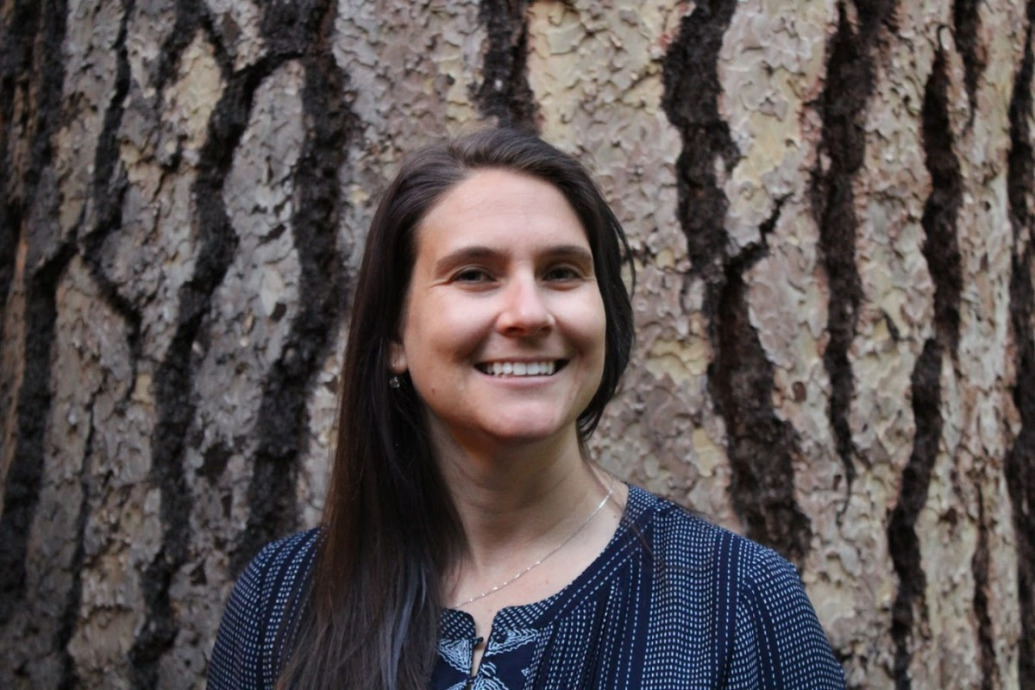I traveled to Latvia for a work trip with Travelport and decided to extend and spend the weekend in Riga to see the city and an old friend. I left on Halloween (had a kitchen pass from Brendan) and arrived the next day, Thursday, November 1 on a DEN-ORD-BRU-RIX 2 stopover itinerary on United and Air Baltic for the final leg. I easily grabbed a taxi for about 30 Euros at RIX and arrived at my luxurious home for the next 4 nights – the Grand Kempinski Riga hotel.
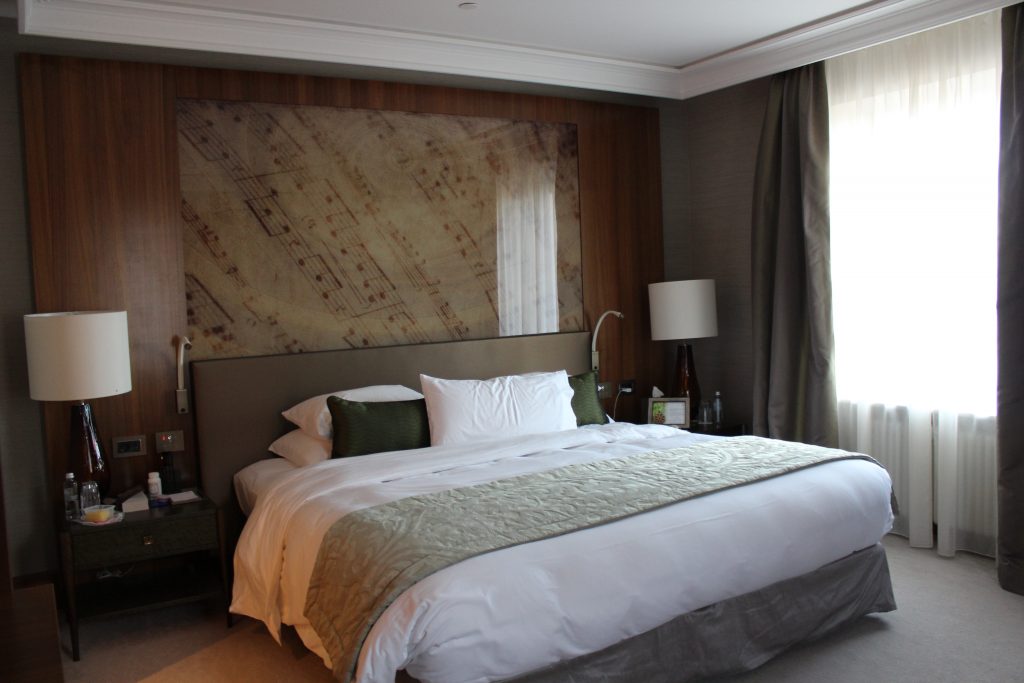
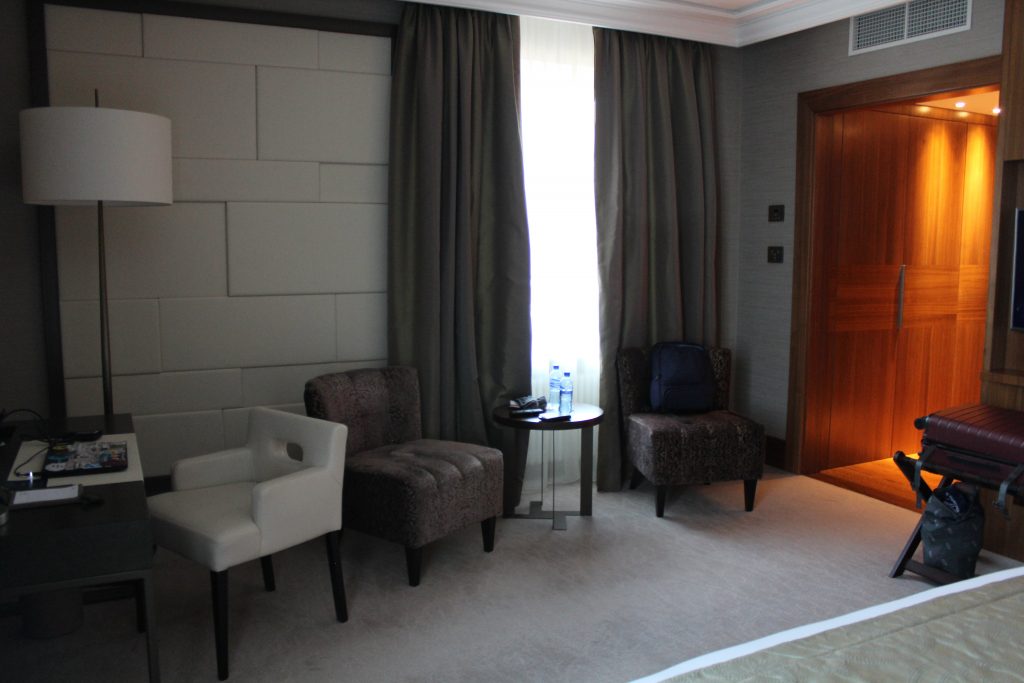
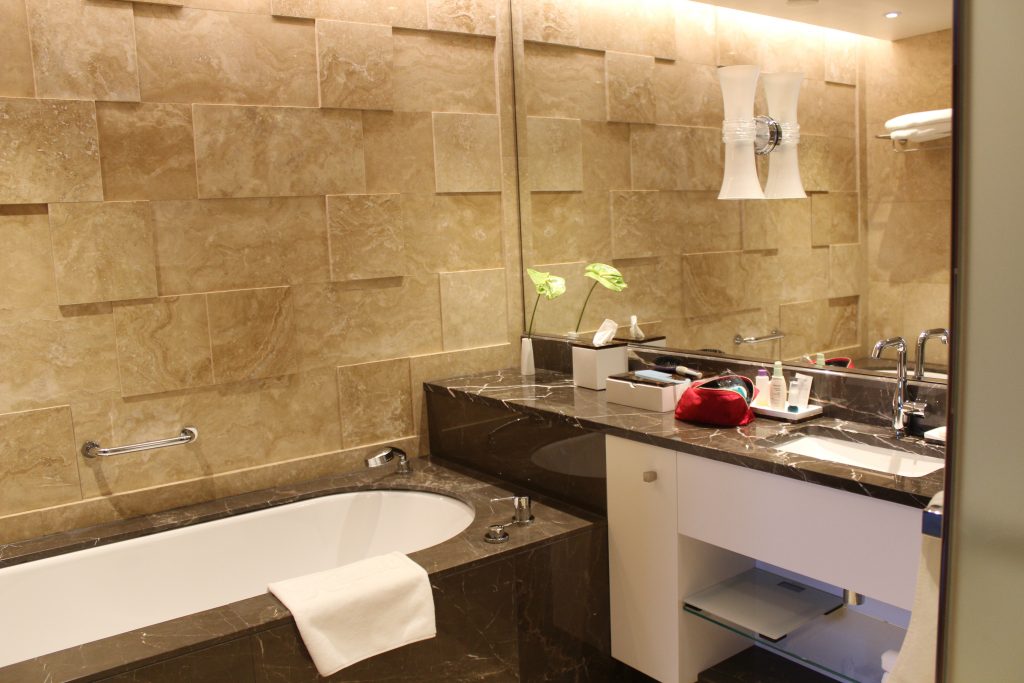
Grand Kempinski Hotel room in Riga
I promptly took a nap, and then by the time I woke up it was time for dinner with some work colleagues at a restaurant near the square with the Laima clock meeting point, across from a popup Christmas market. It was only a few minutes walk from the hotel.

First night in Riga – map also shows additional restaurants I tried when I was there
It was a very pleasant evening and we enjoyed the walk over to Livu Square. The food was delicious (I ordered a caprese salad and a vegetarian stew – I was delighted to find more than a few vegetarian options in this part of the world, which was a difference from when I used to live in Prague). The highlight was a dessert special which has a tower of ornate sugar work that we eventually devoured (no one wanted to be the first one!).
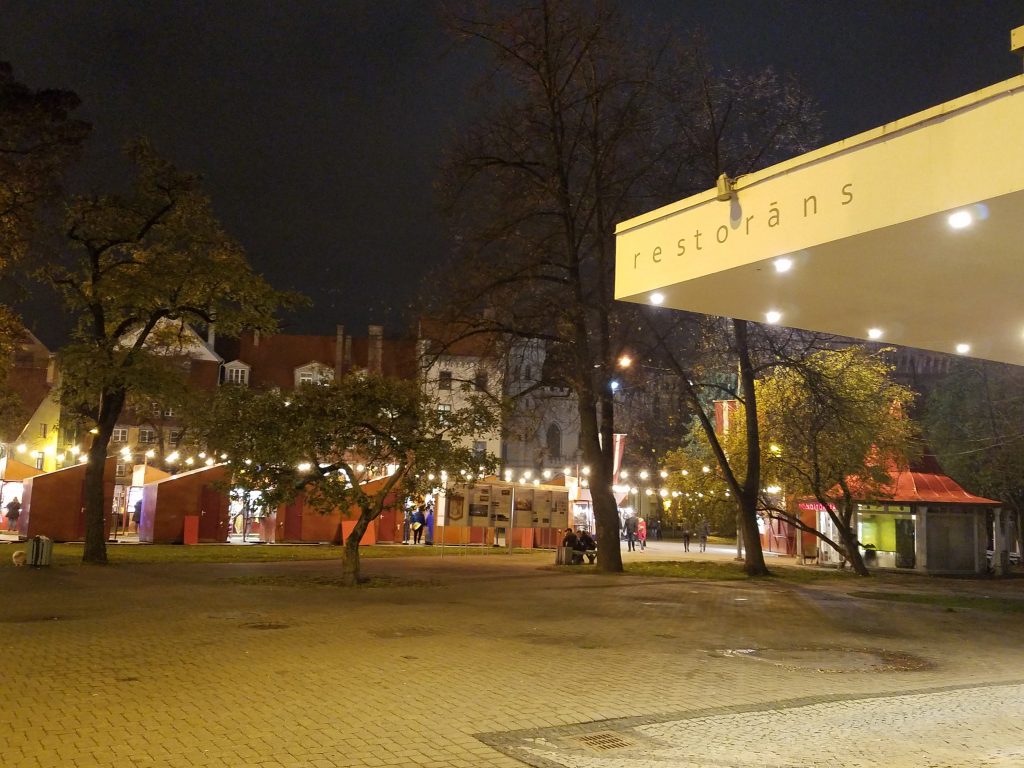
Kaļķu vārti – dinner in Riga
After dinner we walked back to the hotel and I was probably asleep around 10PM. The nap in the afternoon helped me to stay up a little later that night get on to Central Easern European time.
The next morning I slept in and met the team for a pre-customer workshop at 1030AM at the Travelport office, near the Radisson Blu hotel (just across the park from the Grand Kempinski). After some preparation, we walked to the customer site, just down the street, and got started with them at 130PM. For most of the session, we took to the whiteboards.
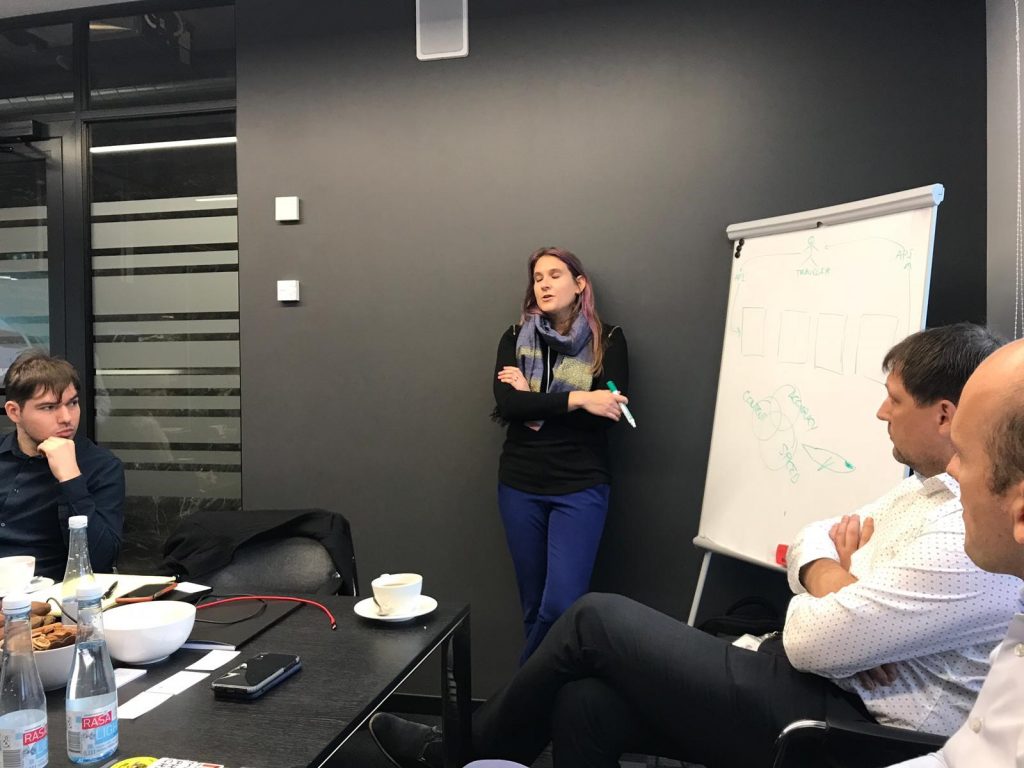
After we finished for the day, we all went out to dinner in Riga – to a highly rated Italian restaurant (Riviera) the customers recommended, just down the street. We had a lovely time.
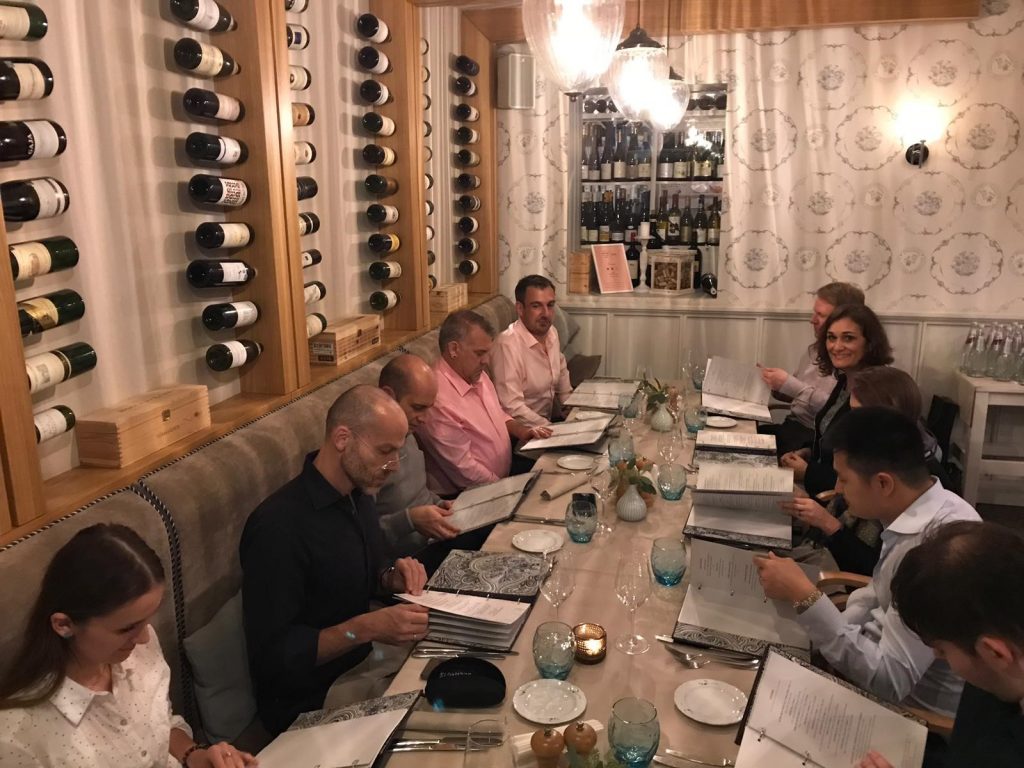 I ordered a beet salad, and lamb as my main dish, and noshed on some delicious bread and appetizers along the way for the table. We chose a bottle of Italian Primitivo and had a bit of a tasting humor due to poor communication – I was choosing between two wines and I thought he was going to let me sample each. I tasted the first, then asked to taste the second, and I decided I liked the first better. He said both tastes were the first, from the same bottle (he missed the point that I wanted to try the second as well, but apparently it didn’t matter because I was making shit up anyways!).
I ordered a beet salad, and lamb as my main dish, and noshed on some delicious bread and appetizers along the way for the table. We chose a bottle of Italian Primitivo and had a bit of a tasting humor due to poor communication – I was choosing between two wines and I thought he was going to let me sample each. I tasted the first, then asked to taste the second, and I decided I liked the first better. He said both tastes were the first, from the same bottle (he missed the point that I wanted to try the second as well, but apparently it didn’t matter because I was making shit up anyways!).
After dinner we had a lovely walk back to the hotel through the park, and I was able to stay up a little later that night, sleeping around midnight. For the next two days, I’d be on my own to explore Riga at my leisure.
I woke up Saturday morning in a bit of a hurry (but still managed to have a light breakfast at the hotel) to get to the meeting point at St Peter’s Church for the 11AM free walking tour, led by a fellow named Toms. This is where I was able to start to get acquainted with old Riga.
We started talking about the general history of the region and of Riga, inhabited as early as the 2nd century by the Livs, an ancient Finnish pagan tribe, and then developing in to a Viking trading city during the early Middle Ages (up to 11th century). The pagan origin is certainly reflected in the city’s culture and mindset – it can be found in art, the love of nature as a past-time, and superstitious practices that still hold on today. Here’s an example of the Latvian sun symbol in Riga’s architecture.
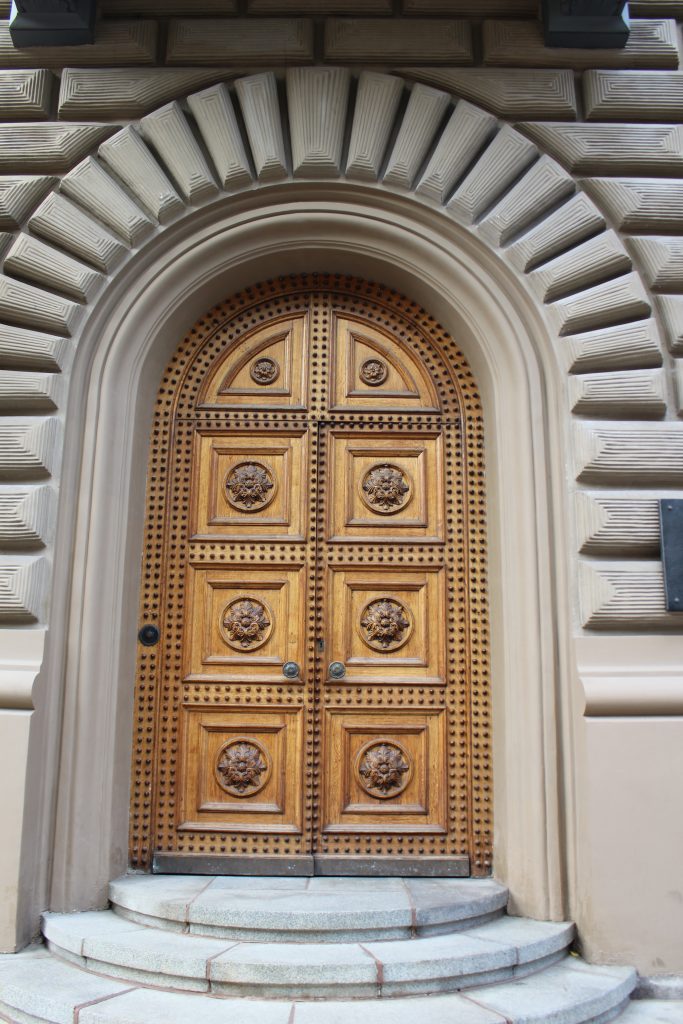
There are several churches side by side, starting off Catholic, that have been re-purposed over the centuries to change with the needs of the people. Catholicism was brought in the 12th/13th century with waves of crusaders, which corresponds with the founding of St Peter’s Church. Latvia would be under the control of the Church, under Bishop Albert for about 50 years.
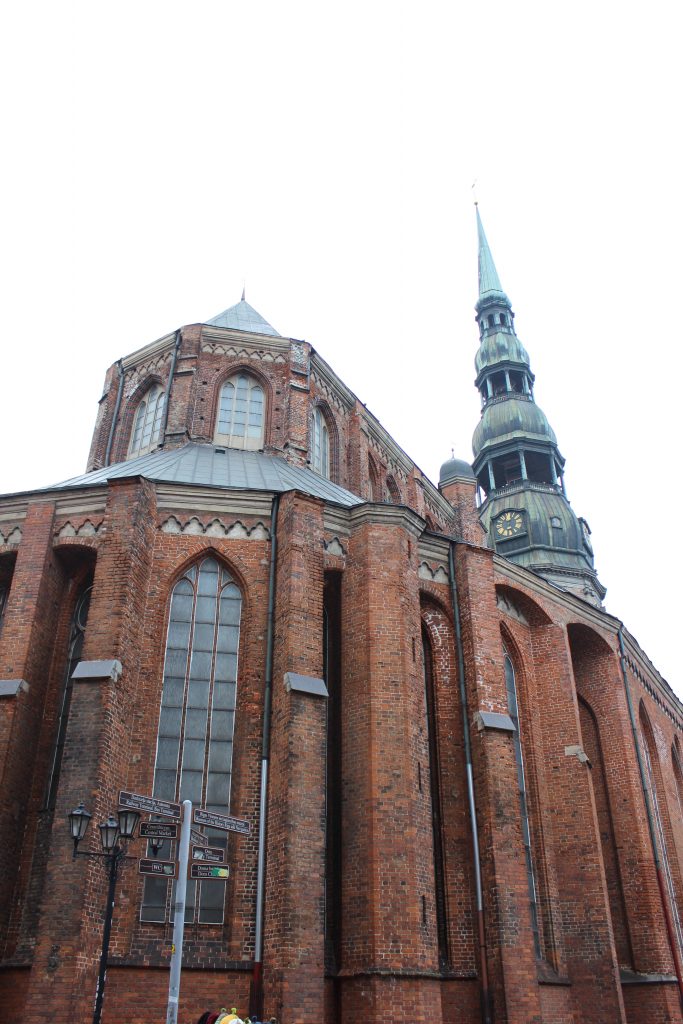
St. Peter’s Church in Riga
In the 13th century, after the Church’s grip had weakened, Riga emerged as a central trading city and joined the German Hanseatic League. This alliance continued for about 300 years in to the 16th century, until the reformation caught hold in Latvia, ushering in a new power center of the Polish-Lithuanian Commonwealth, which had split with the Holy Roman Empire.
St John’s church below began as a Catholic church but is now a Lutheran church, and has been so since the Germans brought Lutheranism during the reformation.
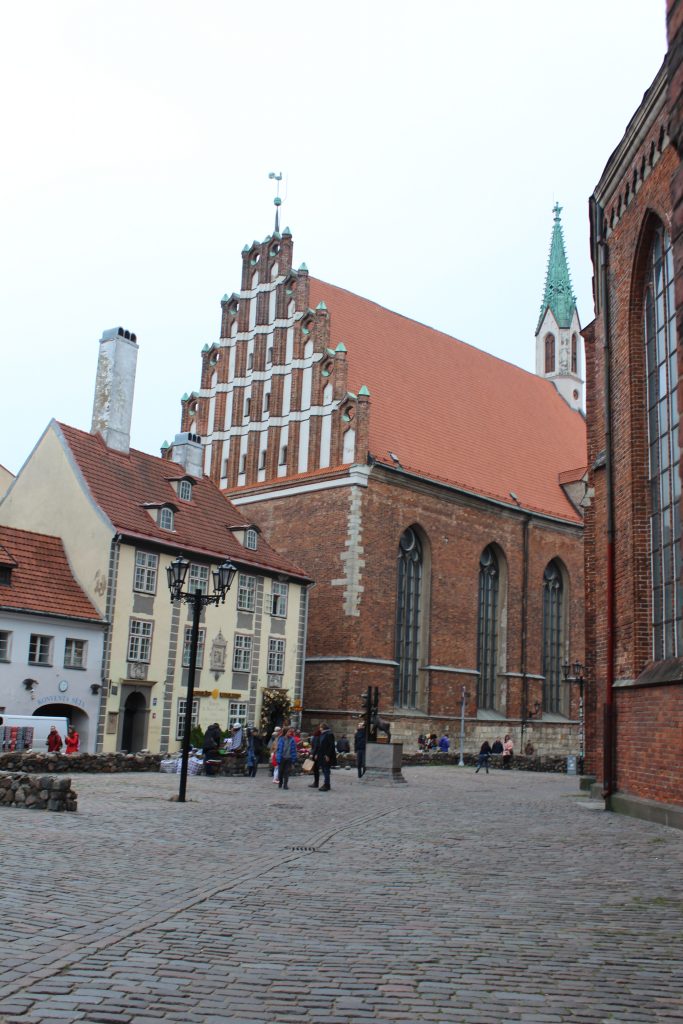
St John’s Church in Riga
After the Polish-Swedish War in 1621, Latvia and Riga fell under control of the Swedish Empire until 1710, when Tsar Peter the Great invaded when the city was weakened by the plague and control changed hands once more. This also marked a significant power shift from Sweden to Russia in Northern Europe. Riga remained under Russian control and influence until World War I, and in fact was the 3rd largest Russian city at the turn of the 19th century.
As Latvians from the countryside began moving to Riga during the Industrial Revolution, a pro-Latvian Nationalist movement began developing strength. This movement led to Latvian independence from Russia on November 18, 1918, after the aftermath of the Russian Revolution and the German invasion of Riga. Latvia remained independent until 1940, when the Russians once again occupied it, and Latvian President Karlis Ulmanis was forced to approve a pro-Soviet government through rigged elections. Those opposing were executed, or deported to Siberia. Jews were also among the targeted population deported to either Concentration Camps or Siberia. According to Wikipedia, in 1989, the percentage of Latvians in Riga had fallen to 36.5%. Toms mentioned later that today it’s about 55% ethnic Latvian, 45% ethnic Russian.
I also enjoyed seeing the influence of other cultures throughout the city – German, Swedish, Russian. The Bremen musicians shows threads of shared culture between Latvia and Germany.
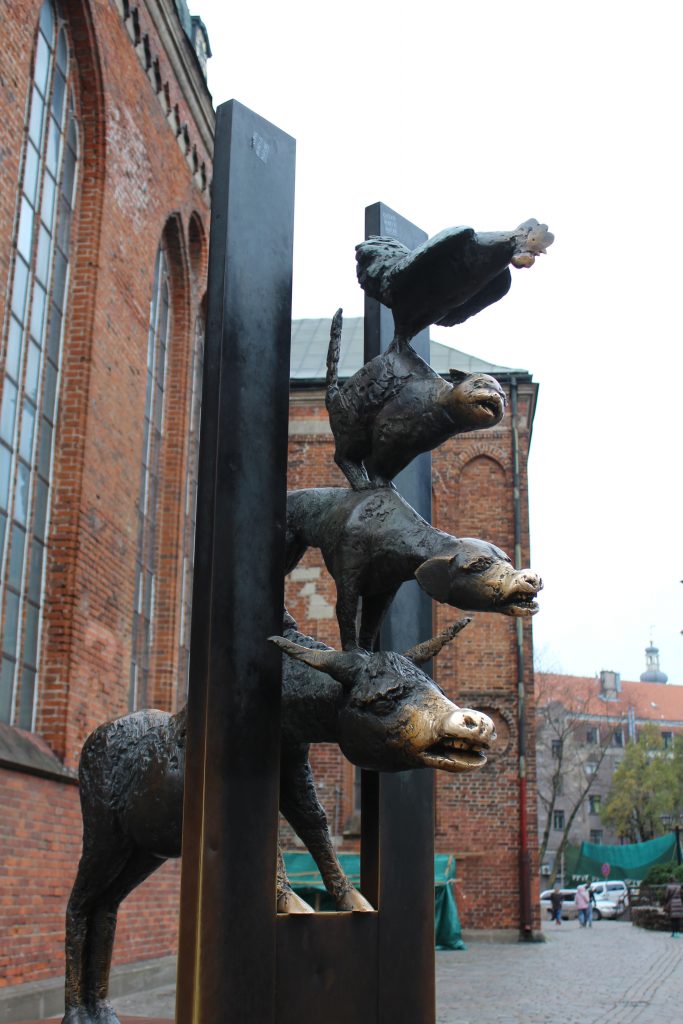
Bremen musicians in St Peter’s square
After that history lesson we continued our walking tour back to the square with the Christmas market and went by German composer Richard Wagner’s studio when he lived in Riga for 2 years (1837-39).
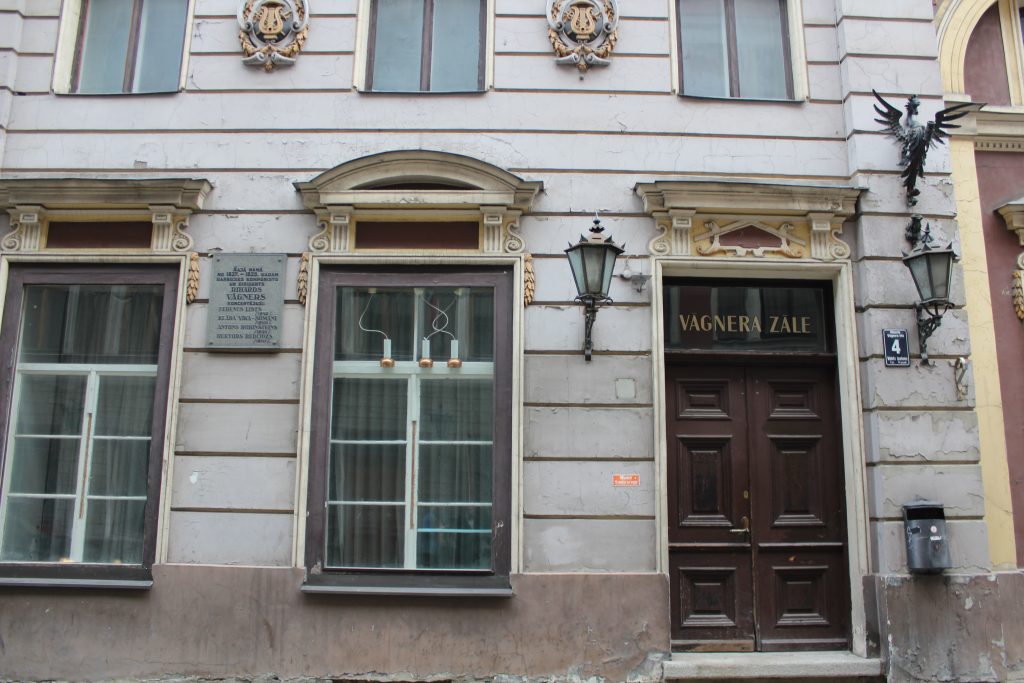
Wagner’s studio in Riga
And then we were back in Livu Square where I had dinner the first night.
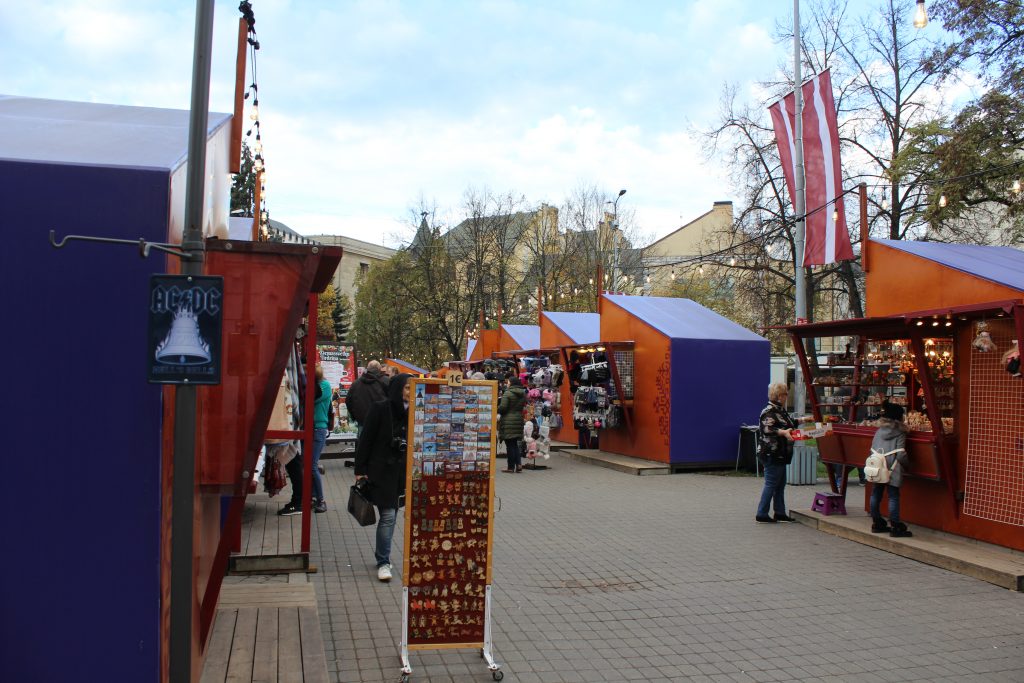
Riga Christmas market
Toms pointed out that this square used be enclosed by 3 sides prior to World Ware II, but was destroyed and then rebuilt in the 1950s, leaving one of the three sides out. You could see the remnant of the corner that should have been there in the buildings left behind. The other interesting thing about this square is the plaque made to honor the first first motion picture screening, exhibited in both Paris and Riga in 1895/1896.
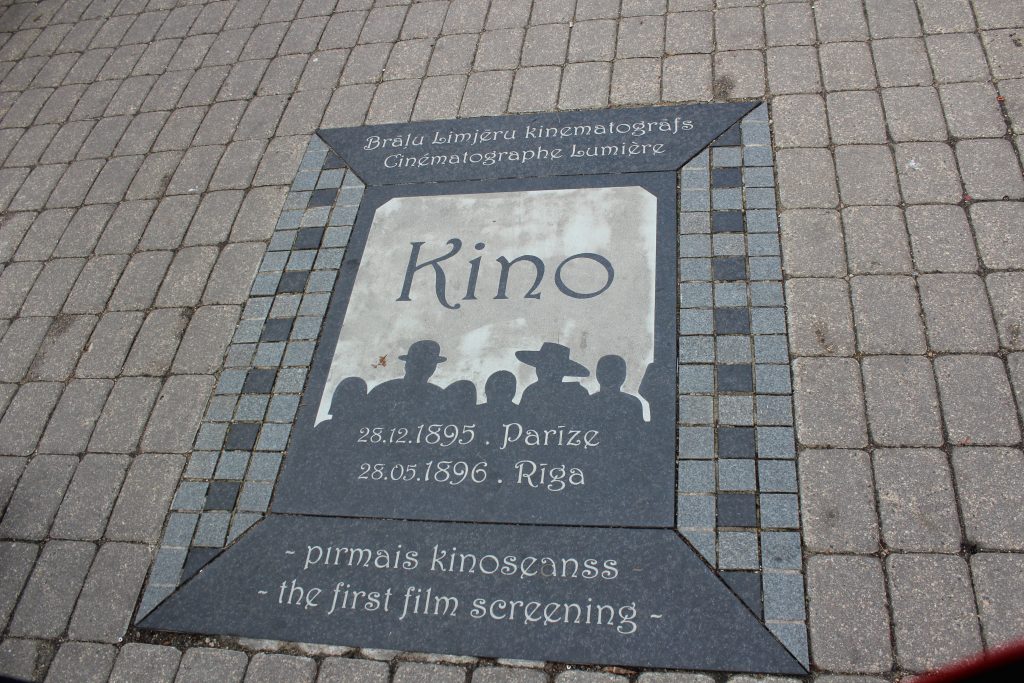
We then continued on with our walk to discuss the significance of the German Hanseatic League in 16th century Riga, a merchant trading, economic, and political association. Several buildings around Livu Square were associated with this trading block, giving rise to the more modern-day Latvian Great Guild Building that was established in the 1850s but with origins in the 14th century (now the home of the Latvian National Symphony Orchestra).
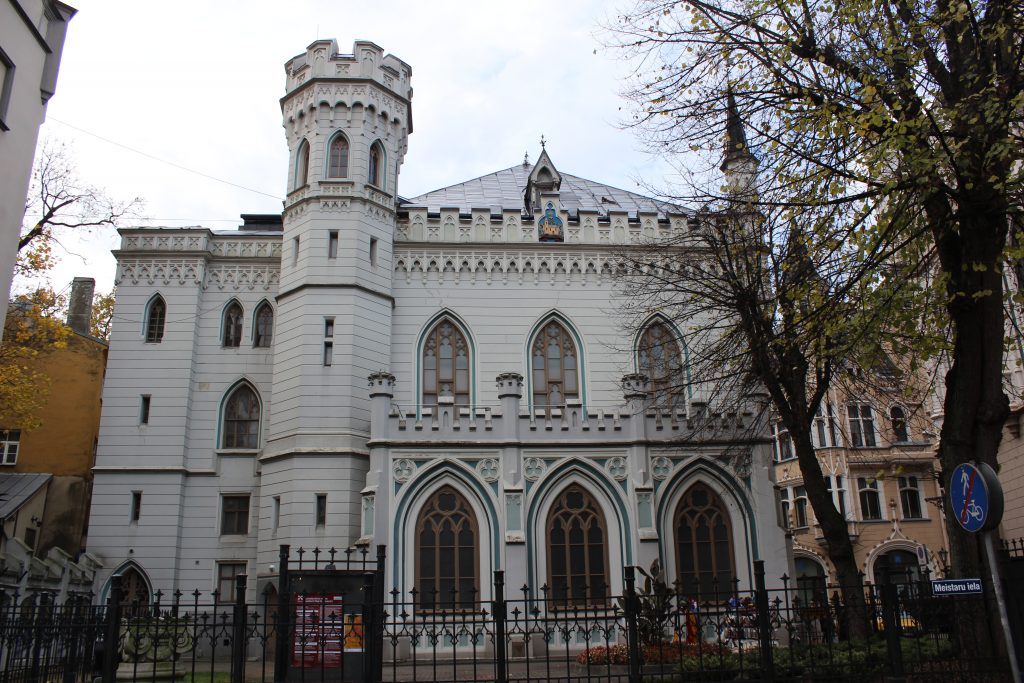
Merchant buildings in Riga
The modern Great Guild building gave rise to a feud, the outcome of which now is one of the more famous landmarks in Riga – the Cat House. The story goes like this. A wealthy 19th century merchant wanted to join the Great Guild, but was refused entry. The merchant felt snubbed, and his reaction was to build a large house just at the footsteps of the guild building (architect was Friedrich Scheffel, who built in the Art Nouveau and Medieval styles), and place a cat statue on the roof with it’s tail pointed to the guild. It was basically his “Fuck you” statement to the guild. Eventually, he was sued by the Guild and made to turn the statue around. We get to enjoy the famous cat today on the Cat House in Riga as a result.
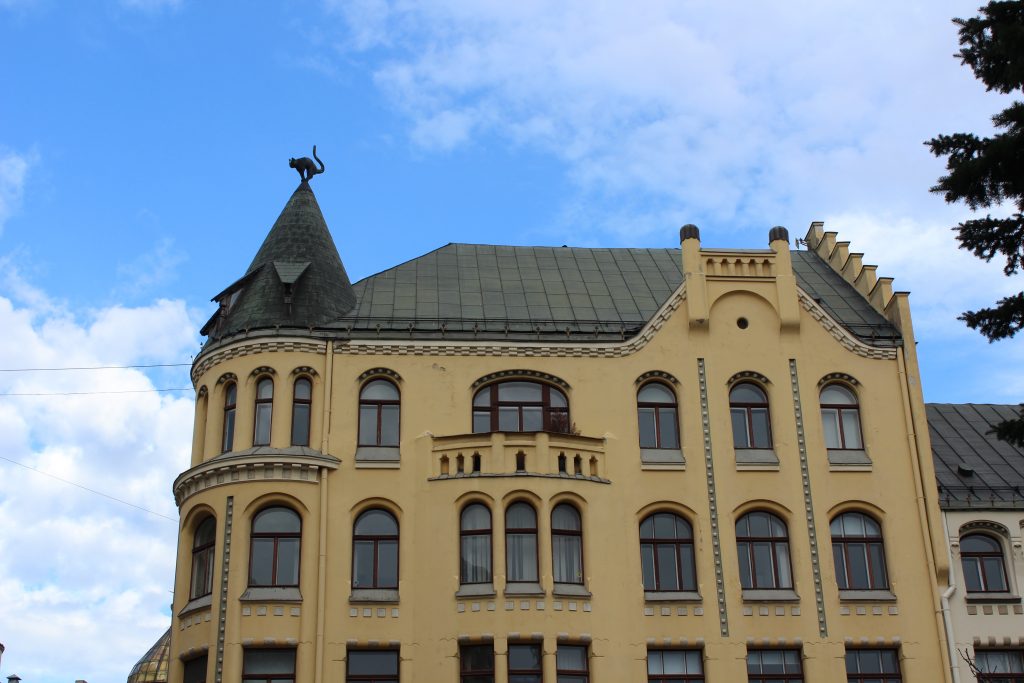
Cat House in Riga
The Old Riga walking tour continued to the Dome Church (Riga Cathedral – Lutheran) square. This church was founded in the 12th century and evolved over the millennium, with many additions such as the “elevation” of portions of the church architecturally 10 feet above the old Riga city streets (modern Riga is literally on top of ancient Riga).
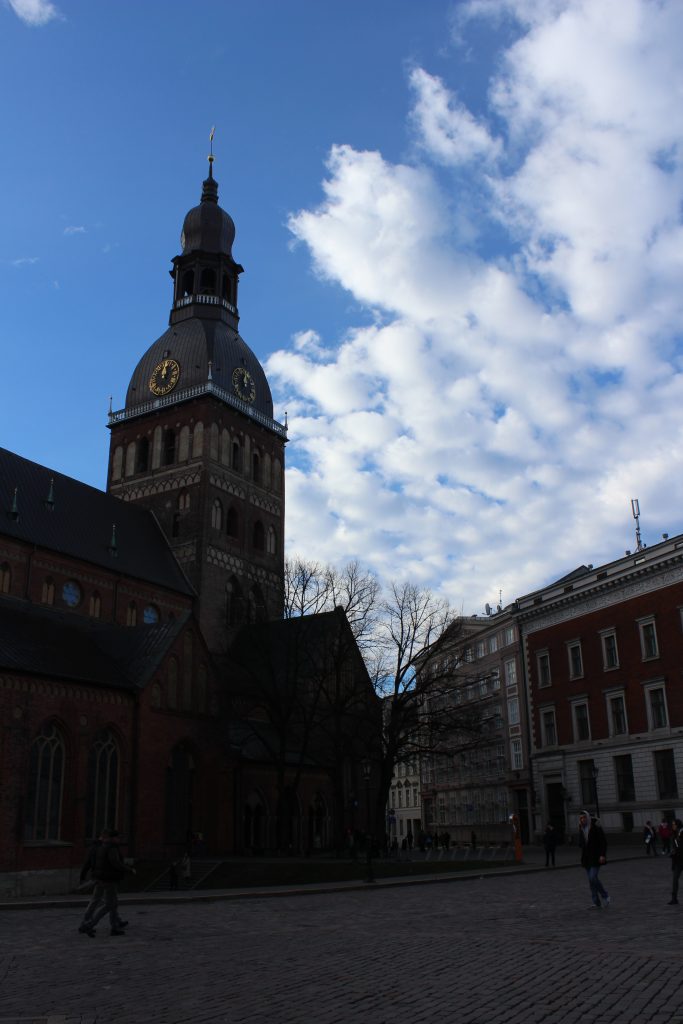
Dome Church
There were also some beautiful buildings and murals in this same square.
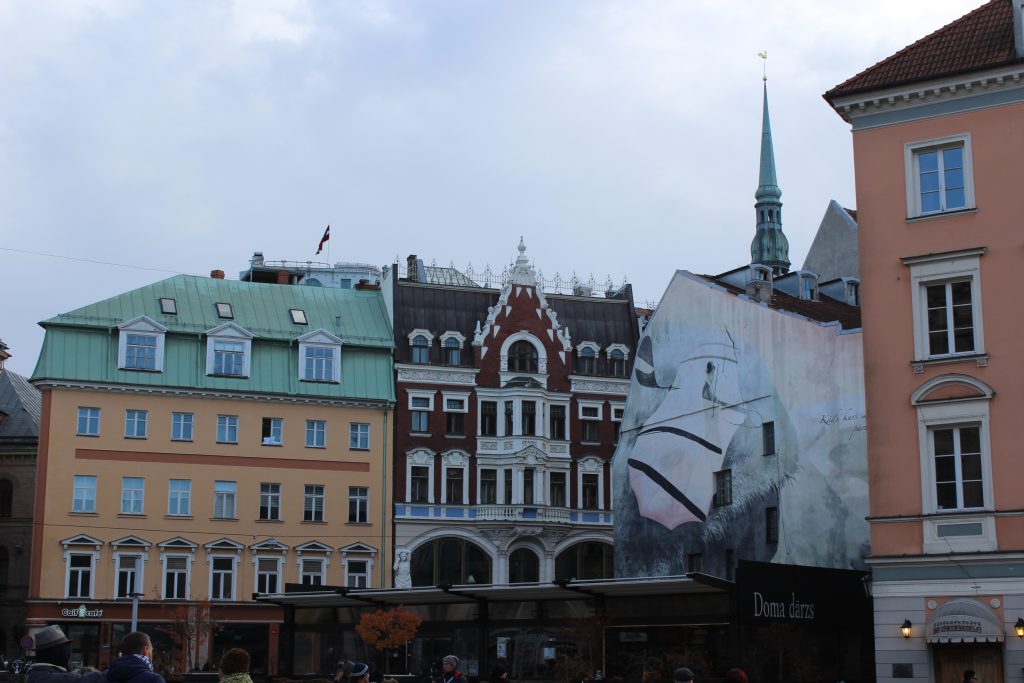
Continuing down this street, we talked about some of the more modern Latvian history, the independence movement, and the establishment of a dictator, Kārlis Ulmanis, as the first Prime Minister. Latvians today have mixed feelings about Ulmanis, considering this time period as the “good old days” despite the nationalist, authoritarian regime, given the number of positive social and economics changes the regime ushered in and mantra of “Latvia’s sun shines equally over everyone” which supported non-violence. He was ultimately overthrown and forced to resign when the Russians rolled in in 1940, and exiled to Siberia, where he probably died.
Along our walk we went by the old Latvia Radio building, established in 1925, which was an important element of the Latvian cultural revival started under Ulmanis. This building also has modern historical significance, with bullet holes made in 1991, when Soviet troops made one of their last attempts to suppress Latvian independence.
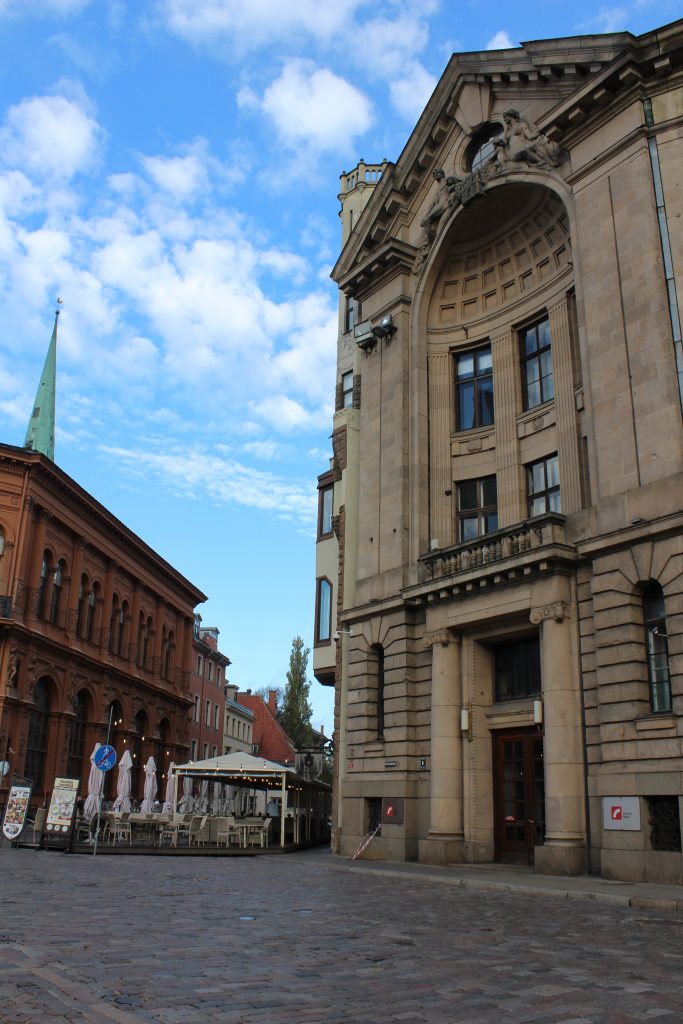
We continued our walk to the Three Brothers, which are 3 houses in a row that reflect Latvian architecture over the centuries.
The building in 17 Maza Pils Street is the oldest, dating from the late 15th century – Gothic and early Renaissance in style. 19 Maza Pils Street, has an exterior dating from 1646, and is Dutch mannerism in style. 21 Maza Pils Street dates from the 17th century. and is Baroque in style.
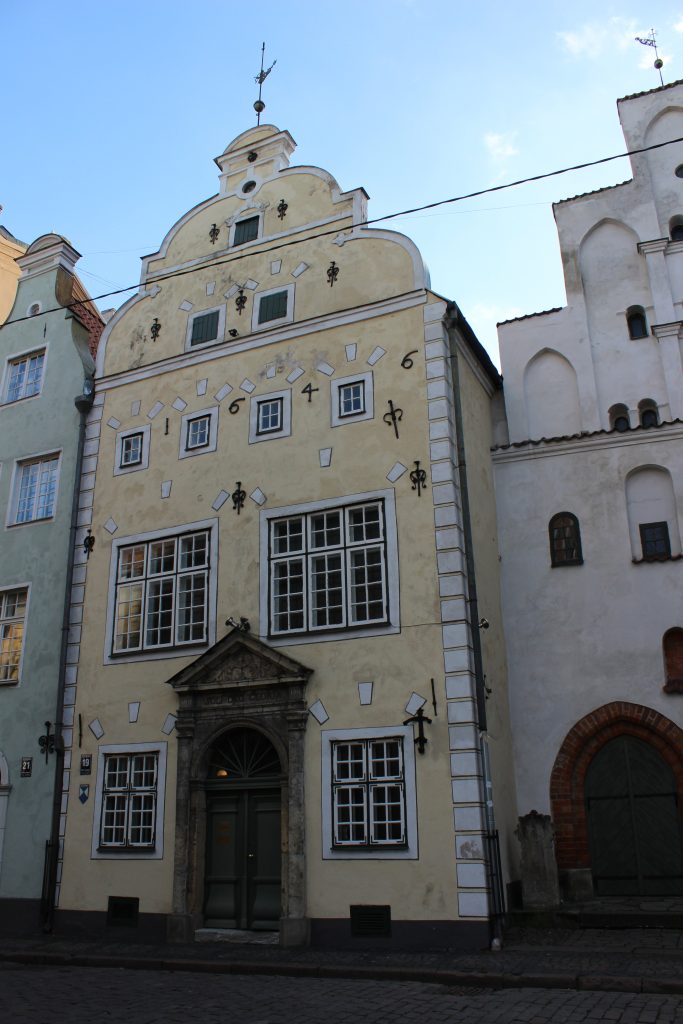
Three Brothers in Riga
On the last stretch of our historical narrative of Old Riga, we walked through and area with a church dating back from 1225, next to the Parliament building, where we stopped to hear more about the political structure and parties that exist today.
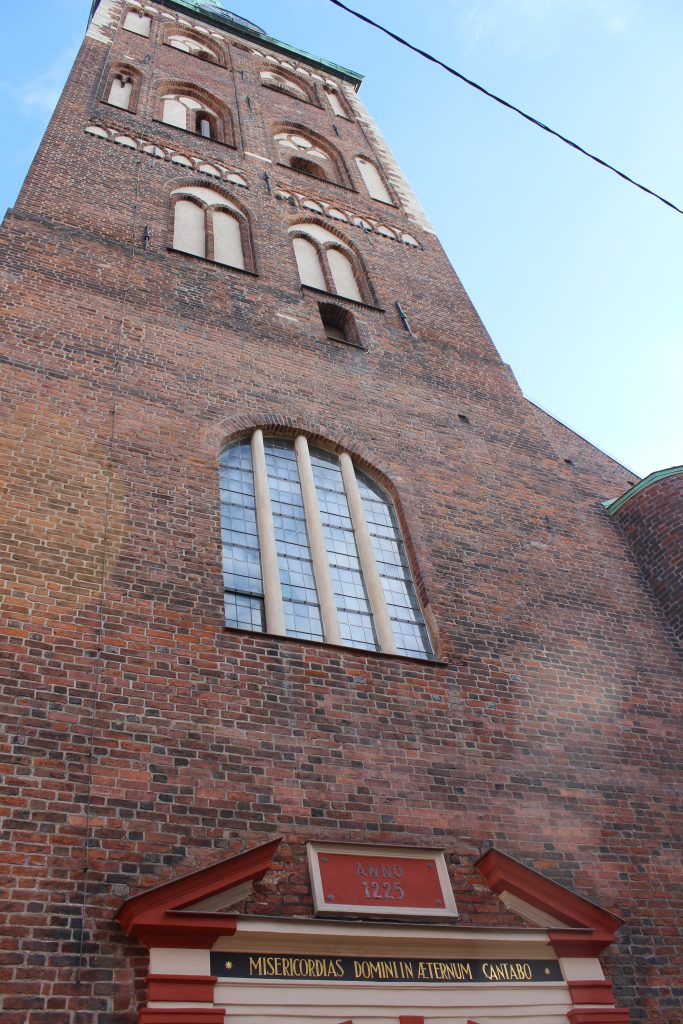
We then continued along a narrow alleyway to the Swedish gate, which marks the original wall between Old Riga and newer Riga, dating to the 15th century. We talked about the sewage system a little running beneath this alley.
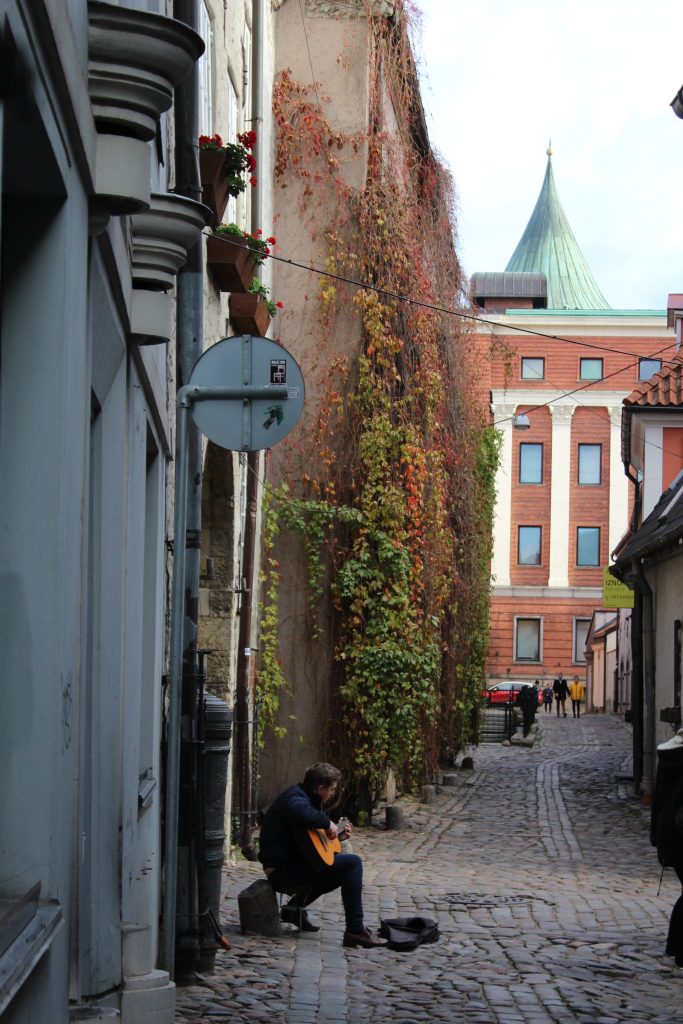
We made our way to the Swedish Gate where we took a group picture, and then on to the Powder Tower. We paused at Jacob’s Barracks, built in the 18th century to fortify the city – and now they divide Riga between new and old and are home to restaurants and shops.
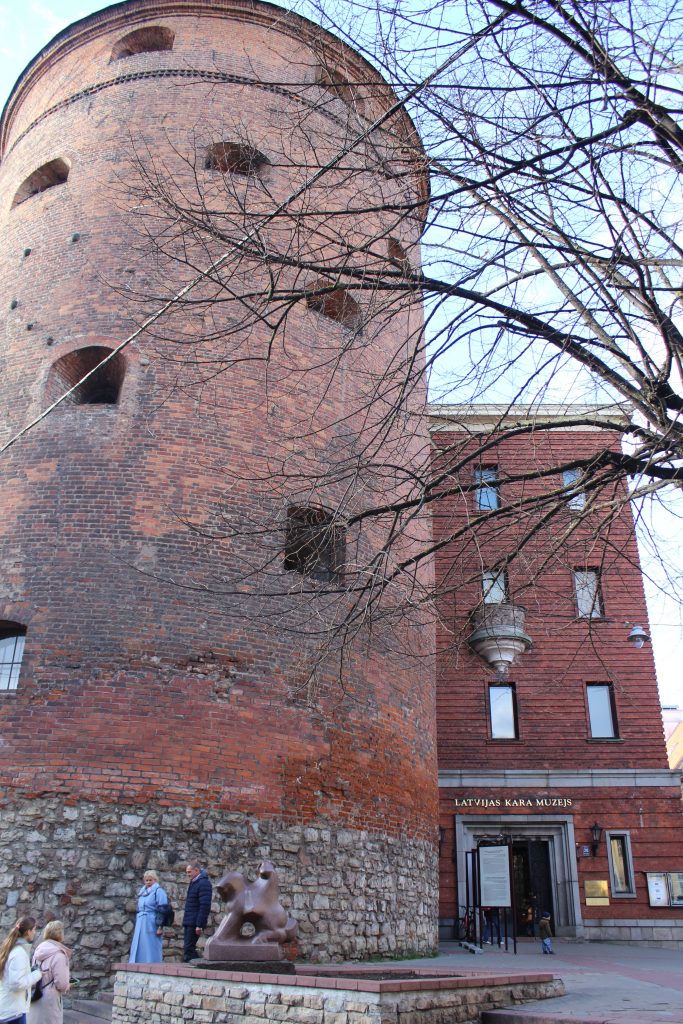
Powder Tower in Riga
We ended up at the Beer House where we sat for a few minutes going over some additional options of things to do around the city, including an option to go to Jurmala by train, which I seriously considered for Sunday (but ultimately slept too long). And that wrapped up the tour!
I headed back to the hotel, took a nap, and then went to the gym prior to going out again for dinner solo. I ended up at a place called Garaze, which my Latvian girlfriend from my Thunderbird MBA program recommended. It had pretty memorable decor, using old train seats as bar stools.
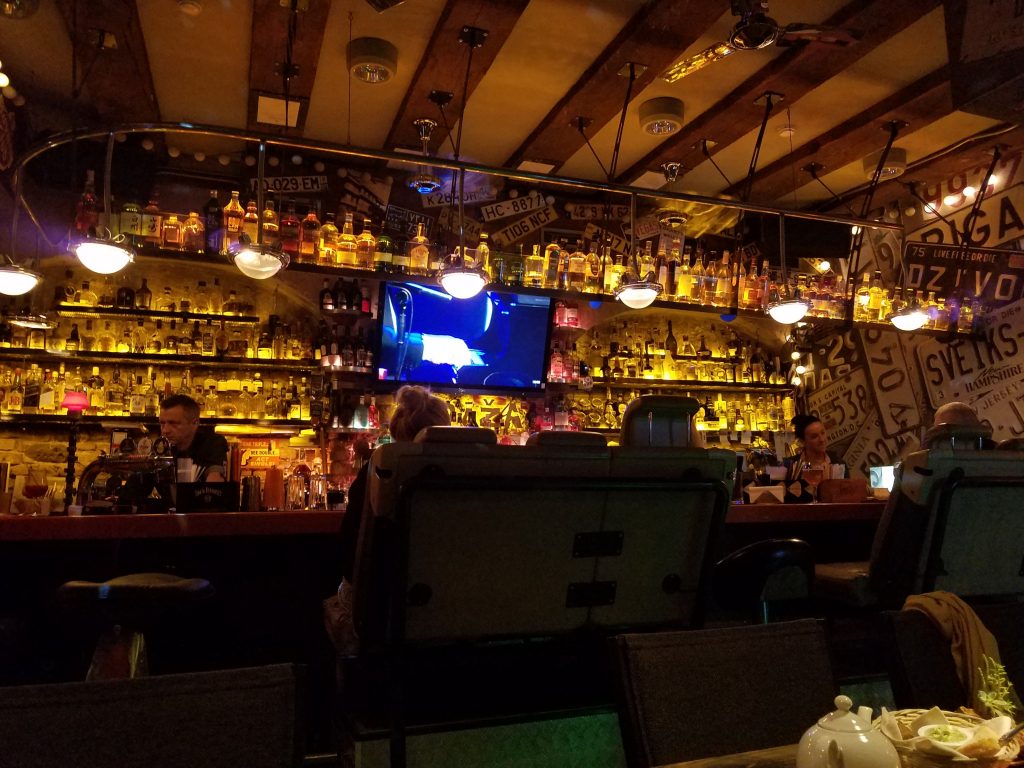
Garaze ambience in Riga
I enjoyed a number of Latvian specialties while at Garaze. The first was Black Currant Balsam – a Latvian liqueur. Strong, sweet, and sour. Not my cup of tea, but interesting to try.
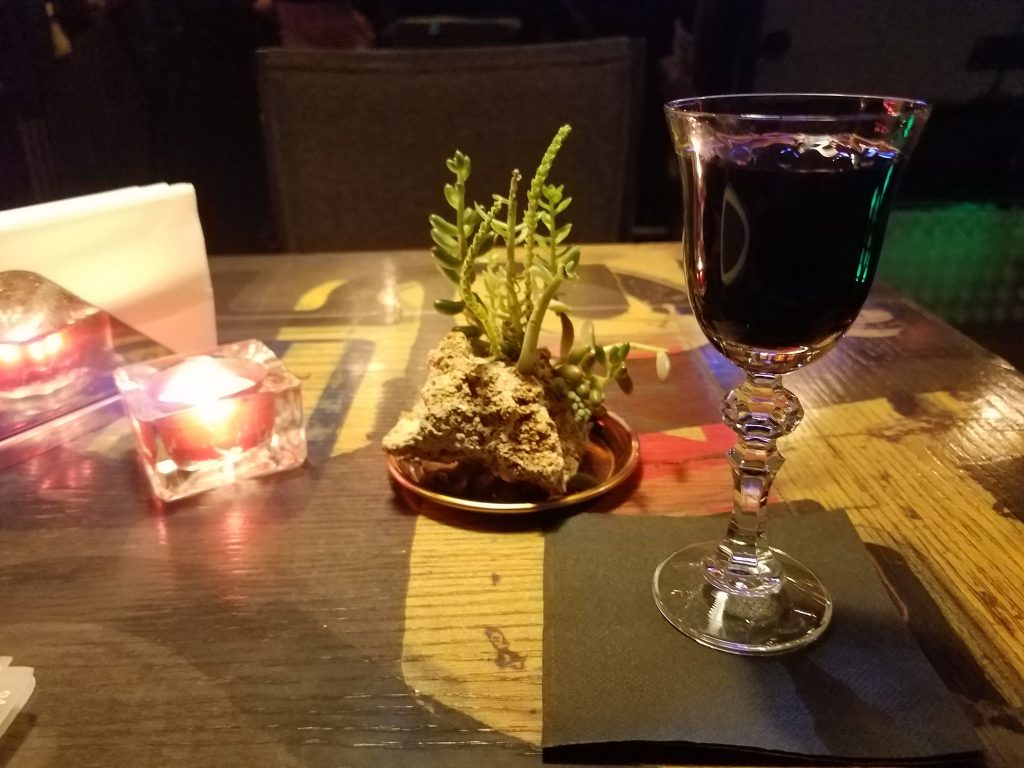
I followed it by an amazing gin and soda with cucumber, which I had never tried before and really liked.
For dinner, I had a goat cheese and beet salad, a selection of breads with dill butter (dill is apparently a thing here!), and some mushroom cream soup (picking mushrooms is a national past time apparently). All the food was delicious and I really enjoyed the ambiance.
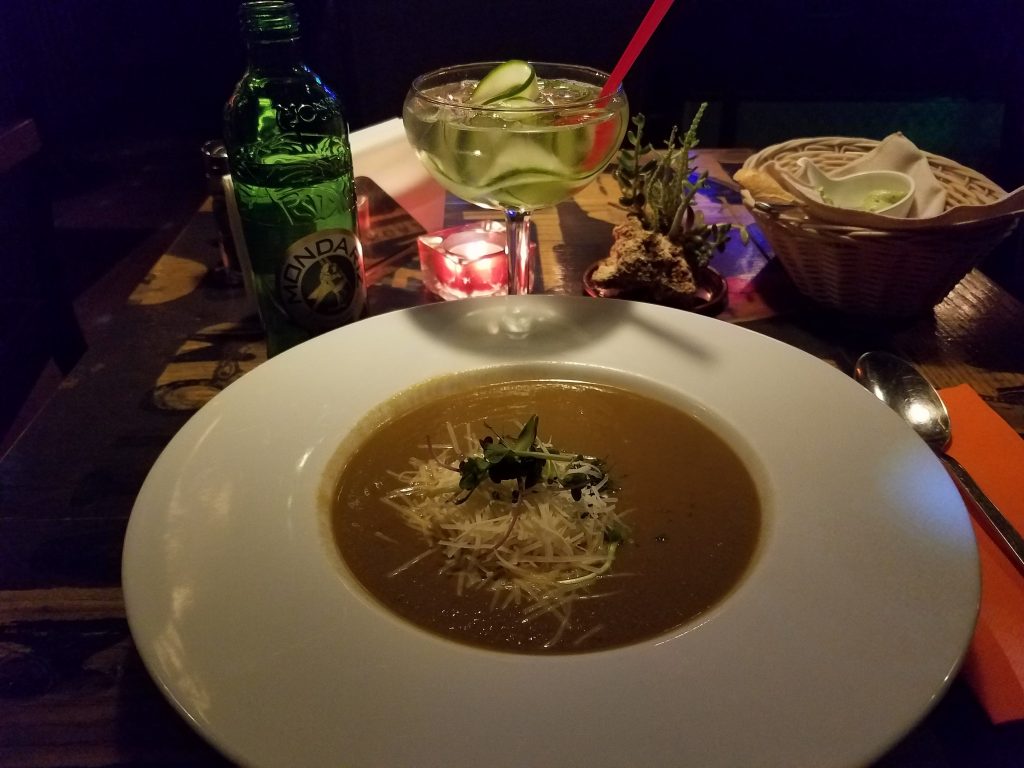
After dinner I took a long walk back to the hotel and then video chatted with Brendan before watching some Netflix (The “Better Call Saul” newest season is available in Europe but not in the US!) and getting some rest. I had every intention to wake up at 9AM to catch an 11AM train to the seaside resort town Jurmala, which has stunning Russian villas and architecture – but I slept until about noon. Oh well.
The plan for my last day in Riga now became one of relaxation. I spent the afternoon at the gym and the hotel spa, and then ventured out around 4PM to do a little souvenir shopping for Brendan (ended up buying a Riga cat Christmas ornament), and eventually met my Latvian friend Madara at a place near the river called the Cave. It was a live music venue that was also an extensive restaurant with great beer selections.
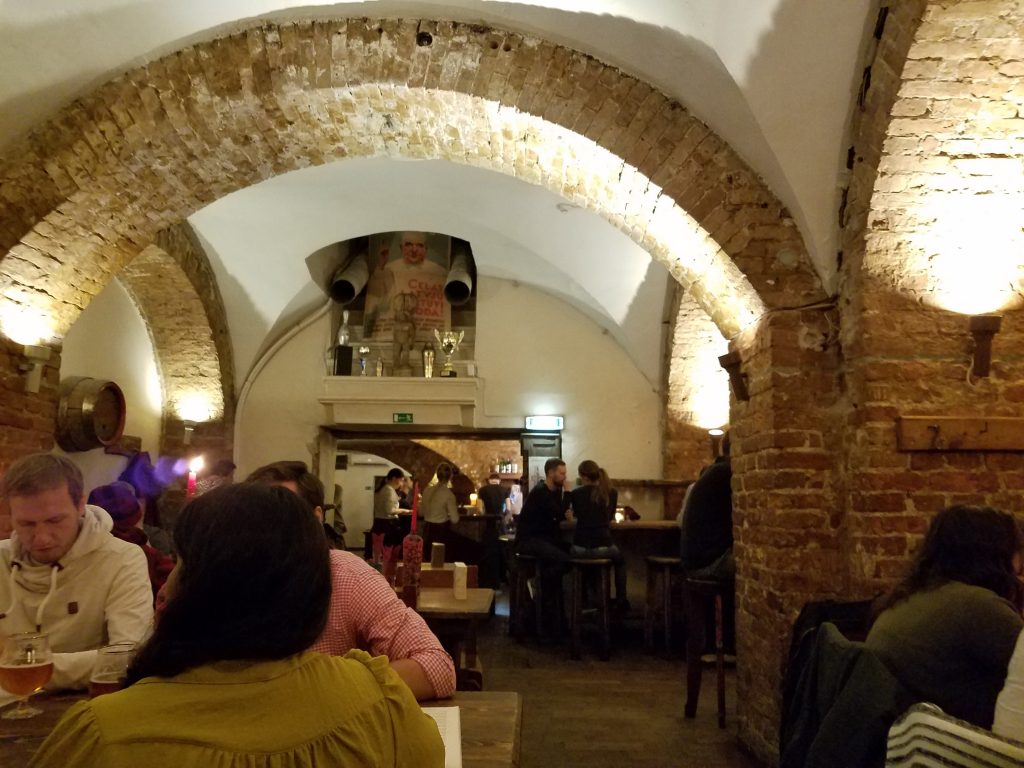
The Cave – 19 Peldu Iela
I had a very typical dark Latvian ale – it was delicious!
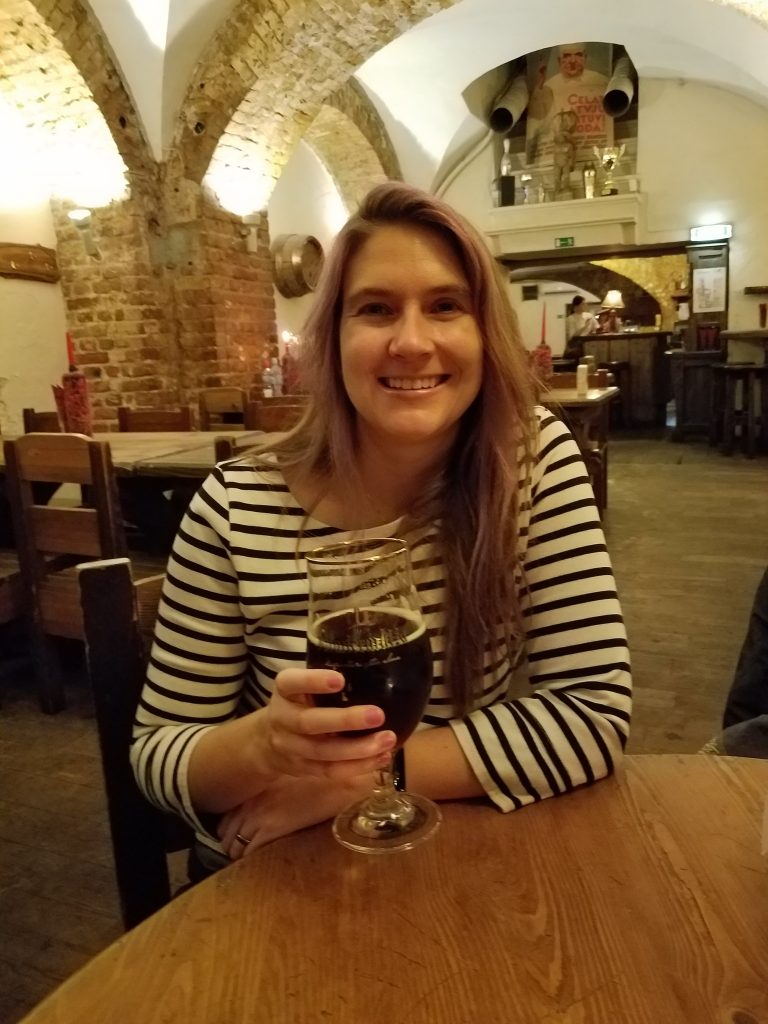
CJ at the Cave in Riga
Spent a few hours catching up with Madara, who works at Philip Morris based out of the Riga office. She recently bought an apartment in new Riga (a few miles from where we met up), has a boyfriend, and has continued her love of sports and the outdoors through orienteering races through the Latvian forests. It was really nice to see her.
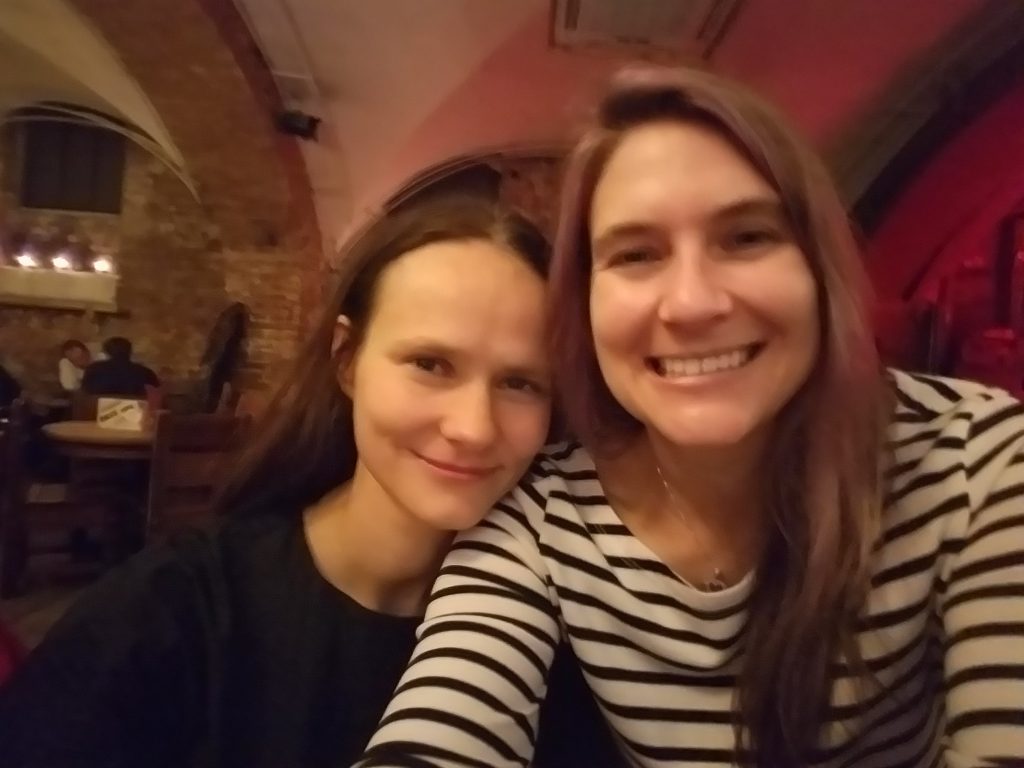
CJ and Madara
Based on another one of Madara’s recommendations, I decided to have dinner in the Art Nouveau area of Riga to the North of Old Riga, near the university. The restaurant was called Burga. Here is an example of the Art Nouveau style that I explored around the University area on my way to Burga (since I was there at night it was hard to capture a good photo).
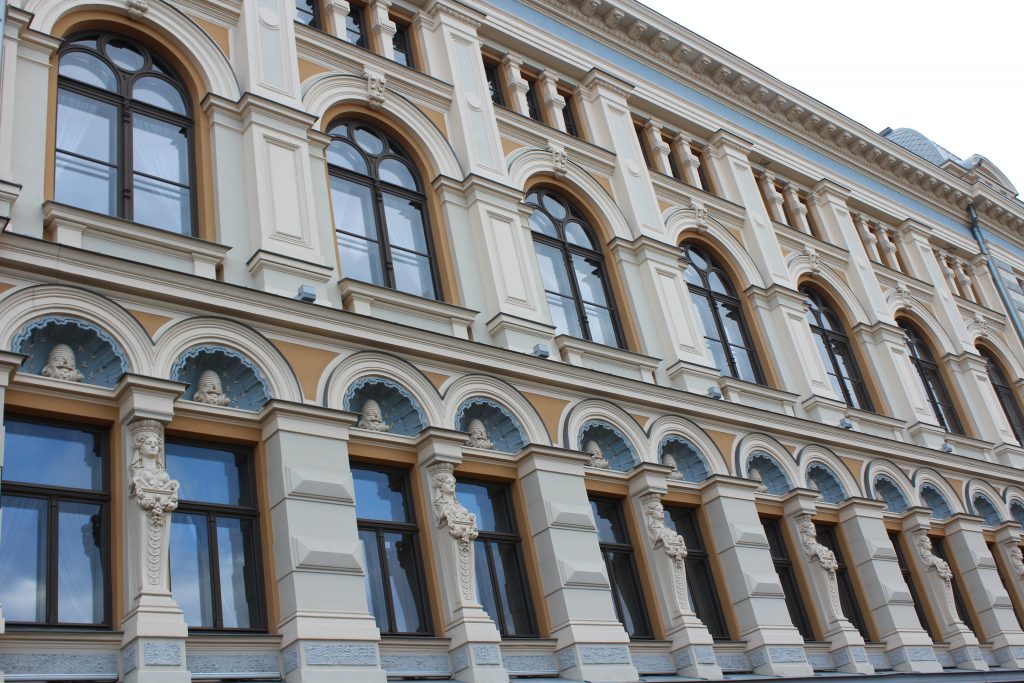
I had to pee really badly so I didn’t get a chance to stop and linger around the university, opting to make a beeline for Burga. I easily got a table (sat next to a group of German college students) and was already making use of the restaurant’s free WiFi.
I ordered a few glass of Primitivo, a Caesar salad that Madara said was killer (she didn’t lie!), followed by a main course of potato pancakes with mushroom sauce. 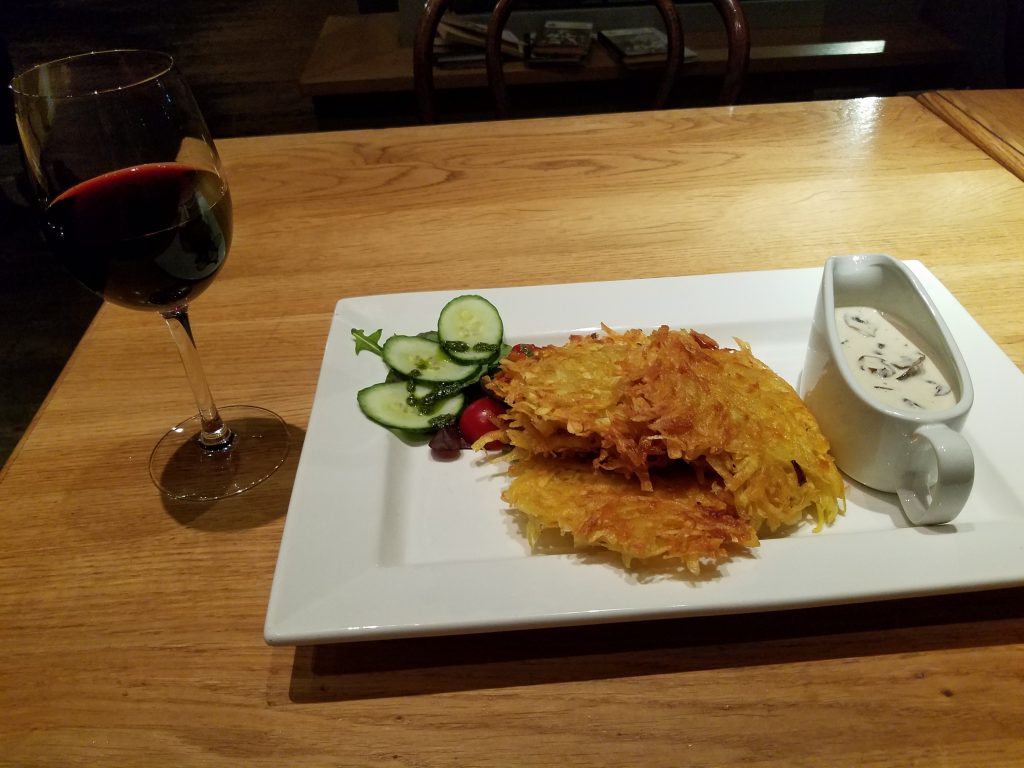 The other option was lingonberries, but that just seemed too Swedish for the moment. I finished with an apple strudel in a hot pocket format that was somewhat unexpected, and also off on the ratios (pie crust to filling). It was the worst part of the meal, but I was thrilled that it came with ice cream!
The other option was lingonberries, but that just seemed too Swedish for the moment. I finished with an apple strudel in a hot pocket format that was somewhat unexpected, and also off on the ratios (pie crust to filling). It was the worst part of the meal, but I was thrilled that it came with ice cream!
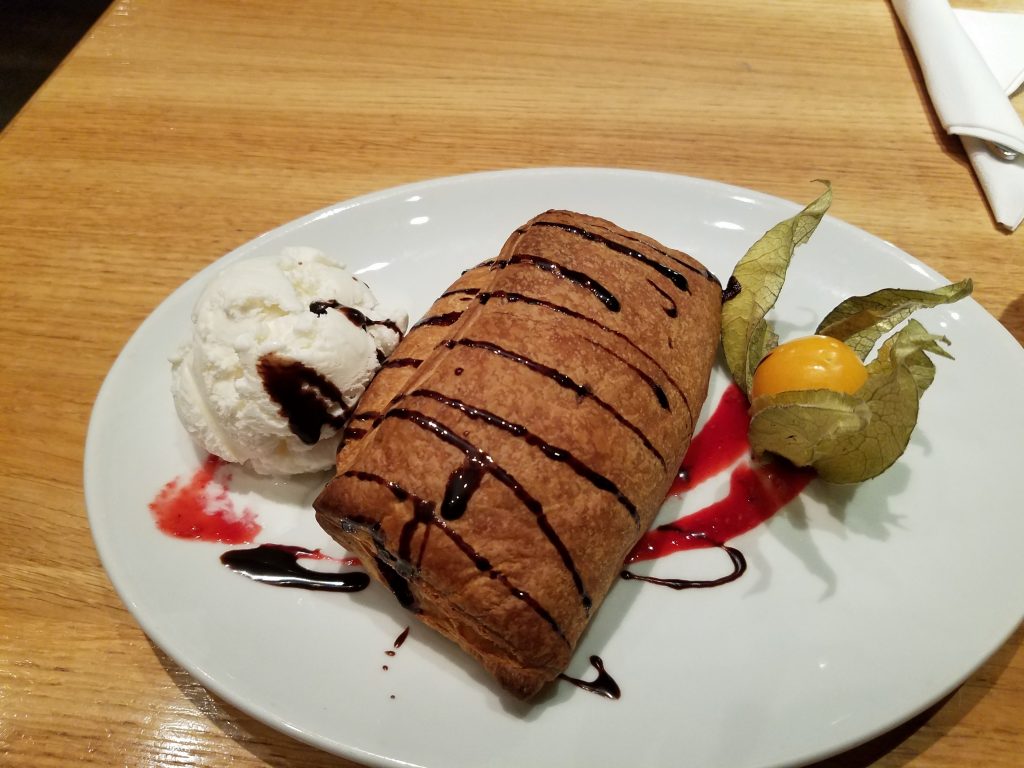
Apple strudel at Burga in Riga
After Burga, I had a lovely stroll home through the two parks, through Laima square with the clock, and back to the Grand Kempsinski. I’d be waking up at 430AM to catch my return RIX-BRU on AirBaltic, BRU-ORD and ORD-DEN on United legs (all went off without a hitch, and I even was upgraded!) – so I packed and went to bed around midnight. It was a great visit to Latvia, and I was really glad I had the opportunity to take advantage of the Riga weekend and make it a bleisure trip!
